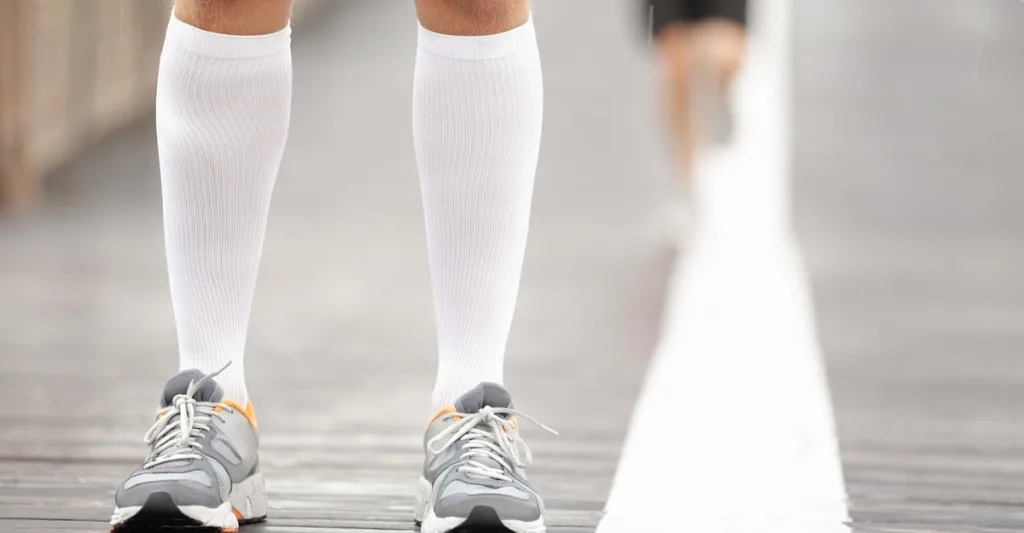Because nurses often spend long hours on their feet, they can be more prone to experiencing fatigue, swelling, and discomfort. Compression socks have become a necessary part of a nurse's uniform, providing much-needed support and promoting better circulation.
Let’s explore the top compression socks for nurses, highlighting their benefits and what to look for when choosing the perfect pair.
Why nurses need compression socks
Before diving into the top picks, it's important to understand why compression socks are beneficial for nurses. Here are some key reasons:
1. Improved circulation
Compression socks apply gentle pressure to the legs, which helps to improve blood flow. This is particularly beneficial for nurses who are on their feet all day, as it can prevent blood from pooling in the lower extremities and reduce the risk of varicose veins and blood clots.
2. Reduced swelling and fatigue
Long shifts can lead to swelling and fatigue in the legs and feet. Compression socks help to minimize swelling by encouraging the flow of blood and lymphatic fluids, which can also reduce feelings of heaviness and discomfort.
3. Enhanced comfort and support
The added support from compression socks can alleviate aches and pains, making it easier for nurses to stay focused and comfortable throughout their shifts. This is especially important for those with existing conditions such as plantar fasciitis or shin splints.
4. Prevention of varicose veins
Varicose veins are a common issue for individuals who stand or sit for prolonged periods. Compression socks can help prevent the development of these veins by supporting the veins and improving blood flow.
Top compression socks for nurses
Here are some of the best compression socks available for nurses, based on comfort, durability, and effectiveness.
1. Physix Gear Sport Compression Socks
Physix Gear Sport Compression Socks are highly rated for their comfort and durability. They offer a perfect blend of compression and support, making them ideal for long shifts.
- Material: Nylon and spandex blend for breathability and stretch
- Compression Level: 20–30 mmHg
- Design: Double-stitched seams for extra durability
- Benefits: Reduces swelling and enhances circulation, keeping legs energized
2. Sockwell Circulator Compression Socks
Sockwell Circulator Compression Socks are known for their comfort and stylish designs. They offer moderate compression, making them suitable for everyday use.
- Material: Merino wool, bamboo rayon, stretch nylon, and spandex
- Compression Level: 15–20 mmHg
- Design: Seamless toe closure and arch support
- Benefits: Natural moisture wicking and odor control, excellent for long shifts
3. Comrad Knee-High Compression Socks
Comrad Knee-High Compression Socks are designed with both comfort and functionality in mind. They provide graduated compression to ensure proper blood flow from the feet to the heart.
- Material: Nylon and spandex blend
- Compression Level: 15–25 mmHg
- Design: Cushioned footbed and arch support
- Benefits: Reduces swelling and fatigue, improves overall comfort during long shifts
4. Nurse Mates Compression Socks
Nurse Mates Compression Socks are specifically designed for healthcare professionals. They offer targeted support and are available in a variety of fun designs. Key features include:
- Material: Nylon and spandex blend
- Compression Level: 12-14 mmHg
- Design: Seamless construction and comfortable fit
- Benefits: Lightweight and breathable, perfect for long hours on the feet
5. CEP Progressive+ Compression Socks
CEP Progressive+ Compression Socks are known for their high-quality construction and effective compression. They are a great choice for nurses who need maximum support.
- Material: Polyamide and elastane
- Compression Level: 20–30 mmHg
- Design: Anatomically padded and moisture-wicking fabric
- Benefits: Enhances performance and recovery, reduces muscle fatigue
6. Bombas Compression Socks
Bombas Compression Socks are praised for their comfort and durability. With a focus on support and fit, these socks are designed to stay in place all day.
- Material: Cotton, polyester, and spandex blend
- Compression Level: 15–20 mmHg
- Design: Honeycomb arch support system
- Benefits: Excellent for long shifts, reducing swelling and providing comfort
7. Zensah Tech+ Compression Socks
Zensah Tech+ Compression Socks are ideal for nurses seeking high-performance socks. They provide targeted compression and superior comfort.
- Material: Nylon and spandex blend
- Compression Level: 20–30 mmHg
- Design: Padded heel and toe for extra comfort
- Benefits: Reduces fatigue and supports muscle recovery, making them great for long shifts
8. Bluemaple Compression Socks
Bluemaple Compression Socks come in a variety pack, offering a combination of style and function. They are suitable for nurses looking for both comfort and affordability.
- Material: Nylon and spandex blend
- Compression Level: 20–30 mmHg
- Design: Breathable fabric with moisture-wicking properties
- Benefits: Prevents swelling and enhances blood flow, ensuring comfort during extended periods of standing
9. Charmking Compression Socks
Charmking Compression Socks are popular for their affordability and effectiveness. They provide good compression and are available in various colors and patterns.
- Material: Nylon and spandex blend
- Compression Level: 15–20 mmHg
- Design: Breathable, durable, and comfortable
- Benefits: Reduces fatigue and swelling, perfect for long shifts
How to choose the right compression socks
When selecting compression socks, consider the following factors to ensure you choose the best pair for your needs:
1. Compression level
Compression levels are measured in millimeters of mercury (mmHg). For nurses, a moderate level of compression (15–20 mmHg) is generally sufficient, but those with specific conditions may benefit from higher compression levels (20–30 mmHg). It's important to consult with your healthcare provider if you're unsure about which level is best for you.
2. Material
The material of the socks can affect their comfort and breathability. Look for socks made from moisture-wicking fabrics like nylon, spandex, and merino wool. These materials help keep your feet dry and comfortable during long shifts.
3. Fit and size
Proper fit is crucial for the effectiveness of compression socks. Make sure to measure your legs according to the manufacturer's instructions to find the right size. Ill-fitting socks can cause discomfort and may not provide the desired benefits.
4. Durability
Compression socks should be durable enough to withstand frequent washing and long hours of use. Look for socks with reinforced seams and high-quality materials to ensure they last.
5. Style and design
While functionality is key, the style and design of compression socks can also be important. Many brands offer a variety of colors and patterns, allowing you to express your personality while still benefiting from the support they provide.
Tips for wearing compression socks
Compression socks are most effective when worn first thing in the morning before any swelling occurs. This helps to maintain optimal blood flow throughout the day.
Make sure your compression socks fit snugly but are not too tight. They should provide even pressure from your ankles to your knees without causing discomfort.
For maximum benefits, wear your compression socks consistently, especially during long shifts. Over time, this can help prevent common issues, such as swelling, varicose veins, and leg fatigue.
Proper care can extend the life of your compression socks. Follow the manufacturer's washing instructions, typically recommending hand washing or using a gentle cycle in the washing machine. Avoid using fabric softeners, as they can break down the elastic fibers.
Compression socks are an invaluable tool for nurses, offering numerous benefits such as improved circulation and reduced swelling. By choosing the right pair and wearing them consistently, nurses can significantly enhance their overall well-being and performance during long shifts.







